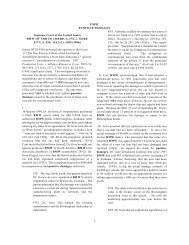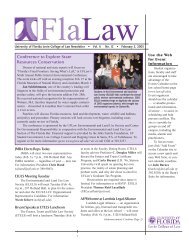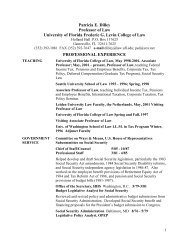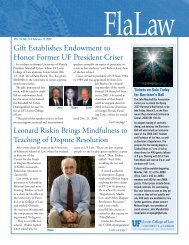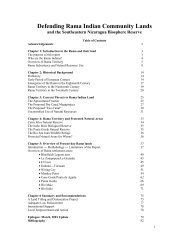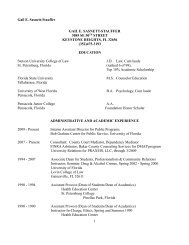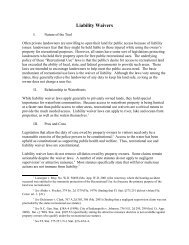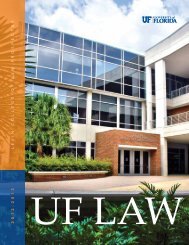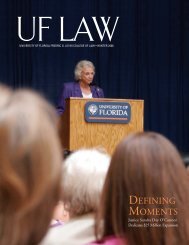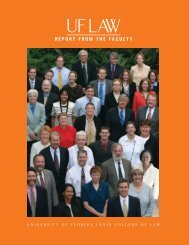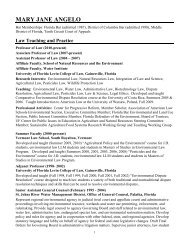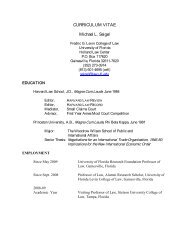If an agreement with the owner or heirsis not reached, expropriated properties navigatethe legal channels and enter NORA’sproperty pipeline for redevelopment or rehabilitation.Once title is obtained, the propertyis then <strong>of</strong>fered for sale to adjacent propertyowners in accordance to the Lot Next DoorOrdinance. Passed in 2007, this ordinanceaims to stabilize and improve neighborhoodscomprised <strong>of</strong> blighted lots and structures. Ifa neighbor does not purchase the property,NORA works with the community to craftredevelopment proposals.“Based on ongoing meetings with neighborhoodleadership, NORA works with thecommunity to craft a request for proposals(RFPs) for rehabilitation and redevelopmentfor neighborhood properties,” Marshall said.“This RFP is published in the Times-Picayuneand transmitted to a database <strong>of</strong> neighborhoodleaders, interested individuals, andnon-pr<strong>of</strong>it and for-pr<strong>of</strong>it developers.”In February 2008, Marshall helped recruita team <strong>of</strong> 12 outside lawyers he now manages.These attorneys are pursuing expropriation<strong>of</strong> more than 850 blighted or abandonedproperties in the city, and each case will takeroughly six to eight months to proceed totrial from the time <strong>of</strong> filing. Using eminentdomain, NORA has or will soon obtain titlesto more than 250 blighted properties. Theseproperties have recently been packaged intoseven different neighborhood RFPs and putout for bid by small entrepreneurs, for-pr<strong>of</strong>itdevelopers, and non-pr<strong>of</strong>it developers. Oncethe new owners take title, they have ninemonths to eliminate health and safety codeviolations and begin redevelopment or rehabilitation.As part <strong>of</strong> the overall recovery scheme,NORA and the city developed recovery targetzones — areas where the city would focususe <strong>of</strong> federal disaster funds. With one <strong>of</strong> thehighest percentages <strong>of</strong> abandoned propertiesin New Orleans, Pontchartrain Park, featuringone <strong>of</strong> the city’s most distinctive parksand a loyal group <strong>of</strong> longtime residents, becamea strategic area <strong>of</strong> focus for NORA’sredevelopment efforts.Developed in 1954, Pontchartrain Parkwas one <strong>of</strong> the first areas in New Orleans designedto provide homeownership to middleandupper-income African-Americans. Thismodel community near the shores <strong>of</strong> LakePontchartrain was built around a city-ownedpark and golf-course designed by JosephM. Bartholomew Sr., a nationally-knownAfrican-American golf course designer. Asfamilies began to move into the community,churches, businesses and schools thrived,including Mary Dora Coghill ElementarySchool, Southern <strong>University</strong> and Dillard <strong>University</strong>.In the 1970s, like many U.S. neighborhoods,the community saw significantresidential turnover. Now, after catastrophicdamage caused by Katrina and its flood waters,the community is largely abandoned.“Before Hurricane Katrina, PontchartrainPark was a very nice neighborhoodwhere kids could safely play in its hugepark,” said Laurie Watt, president <strong>of</strong> GentillyCivic Improvement Association, a coalition<strong>of</strong> 19 neighborhood groups that advocatesfor rehabilitation and redevelopment <strong>of</strong> theirstorm-ravaged neighborhoods. “There was agolf course and a recently opened senior center.It was family-oriented with a lot <strong>of</strong> olderfolks who were the original homeowners.But today, the community suffers from the‘jack-o-lantern effect.’ ”“Louisiana votersjumped on the anti-Kelobandwagon by passingtwo ballot initiatives that...placed restrictions on theresale <strong>of</strong> property...”“This is where a nice rebuilt home is nextdoor to a lot with 8-foot weeds growing nextto a dilapidated house, next to another lot <strong>of</strong>weeds. It’s just like teeth carved in a jack-olantern,except this goes on for blocks,” Wattexplained.According to the U.S. Census Bureau,the population <strong>of</strong> Orleans Parrish in 2005was 453,726. In 2007, the population hadplummeted to 239,124. Using postal recordsto measure recovery, the Greater New OrleansCommunity Data Center determinedthe number <strong>of</strong> households in PontchartrainPark dropped from 1,025 in 2005 to 389 in2008.As NORA’s community liaison, Marshallconsults regularly with community leaderslike Watt to learn the community’s wishes inregard to redevelopment.“John Marshall has been the voice <strong>of</strong>NORA,” Watt said. “He has fielded thousands<strong>of</strong> questions during community meetings andprovided information resources for countlessaction committees. He and his organizationhave done a great job in our community.”Watt added that while there are otheragencies and ongoing efforts addressing abandonedproperty, NORA has consistently beenthere to provide information to action groupsabout current programs and how they work.TROUBLED WATERSDespite NORA’s success rehabilitating abandonedproperties in New Orleans using thestrategy <strong>of</strong> expropriation, eminent domain inthe State <strong>of</strong> Louisiana has caused a politicalpart-in-the-water.At the center <strong>of</strong> this legal storm was the2005 U. S. Supreme Court ruling in Kelo v.City <strong>of</strong> New London, in which the court decidedlocal government could use eminentdomain to take private property for the solepurpose <strong>of</strong> economic development.“The decision created a sort <strong>of</strong> ‘stormsurge’ <strong>of</strong> public backlash,” said Marshall.“Immediately, people became frightened thatthe court’s decision would mean that theirlocal government could take their well-kepthome if the government articulated an economicdevelopment purpose for the expropriationor taking <strong>of</strong> property.”In the wake <strong>of</strong> nationwide outrage followingthe Kelo decision, lawmakers rushedto draft amendments restricting the use <strong>of</strong>eminent domain. According to the NationalConference <strong>of</strong> State Legislatures, 39 statessuccessfully passed measures restrictinggovernment’s ability to seize private landfollowing the Kelo decision.Swept up in this tide <strong>of</strong> public disapproval<strong>of</strong> the Kelo court’s holding, Louisiana votersenacted two constitutional amendments thateliminated the possibility that a local governmentcould use eminent domain to achieveeconomic development. The amendmentsalso had the potential to be interpreted ascircumscribing government’s use <strong>of</strong> eminentdomain to eliminate threats to public healthand safety — a basic governmental powerlong accepted.“Louisiana voters jumped on the anti-Kelo bandwagon by passing two ballot initiativesthat provided a detailed definition<strong>of</strong> ‘public purpose’ and placed restrictionson the resale <strong>of</strong> property that the state hadpreviously expropriated,” said Michael AllanWolf, a UF pr<strong>of</strong>essor <strong>of</strong> law and chapterauthor <strong>of</strong> “Hysteria versus History: PublicUse in the Public Eye,” in a book entitled,Private Property, Community Development,and Eminent Domain.“It seemed as if politicians and activiststhroughout the nation felt the need torespond to the anti-Kelo sentiment, to takeadvantage <strong>of</strong> that sentiment to achievetheir preexisting goal <strong>of</strong> placing restraintson government acquisition and regulationfor real property, or both,” said Wolf whoholds the UF <strong>Levin</strong> <strong>College</strong> <strong>of</strong> <strong>Law</strong> RichardE. Nelson Chair in Local Government.The first measure passed by Louisiana voters32 UF LAW
Homes in the Pontchartrain Parkneighborhood were flooded to theireaves following Katrina when thelevies <strong>of</strong> bordering canals werebreached. Now about two-thirds <strong>of</strong>the homes are unoccupied.was Amendment 5. It provided that an acceptable“public purpose” for expropriationis the “removal <strong>of</strong> a threat to public health orsafety caused by the existing use or disuse <strong>of</strong>the property.” However, the amendment alsostates “property shall not be taken or damagedby the state or its political subdivisionsfor the predominate use by any private personor entity or for the transfer <strong>of</strong> ownershipto any private person or entity.”This provision seemed to challengeNORA’s strategy <strong>of</strong> taking blighted privateproperty and transferring it to another privateentity, such as Habitat for Humanity, andwas in stark contrast to the verdict handeddown in Kelo v. City <strong>of</strong> New London. In theKelo decision, Associate Justice John PaulStevens, writing for the majority, said NewLondon could pursue private developmentunder the Fifth Amendment, which allowsgovernments to take private property if theland is for public use.“Promoting economic development is atraditional and long accepted governmentalfunction, and there is no principled way <strong>of</strong>distinguishing it from the other public purposesthe Court has recognized,” Stevenswrote, adding that local <strong>of</strong>ficials are better positionedthan federal judges to decide what’sbest for the community. Moreover, both themajority opinion and the dissent in Kelo fullyembraced the use <strong>of</strong> eminent domain — andthe transfer <strong>of</strong> expropriated property to thirdparties — when the taking eliminates some“harmful property use.”Amendment 6 arguably undermines theability <strong>of</strong> governments to transfer expropriatedproperty to a third party. The combinedforce <strong>of</strong> the two amendments seems to be amandate that seized property must be heldfor 30 years by the seizing authority beforeit can be transferred to a third party, and thatseized property must be first <strong>of</strong>fered for saleat fair market value to the owner, or the owner’sheirs, from which it was seized. Thesecould negate the city’s incentive to expropriateblighted properties and seem to gut itsstrategy <strong>of</strong> using expropriation to eliminatethreats to public health and safety.However, Marshall said NORA doesn’tbelieve the 2006 constitutional amendmentsprevent it from using its statutory power toexpropriate properties as a means to eliminatethreats to “public health and safety.”“The primary purpose <strong>of</strong> NORA’s expropriation<strong>of</strong> blighted property is not to transferthe property to a third-party,” said Marshal.“It is to accomplish removal <strong>of</strong> a proventhreat to public health or safety.”To force examination <strong>of</strong> the constitutionality<strong>of</strong> the amendments, NORA quietlysought an appropriate suit to make its case.The suit found the agency first.KATHY ANDERSON/THE TIMES-PICAYUNEBURGESS V. NORAIn 1997, the City <strong>of</strong> New Orleans demolishedan abandoned building on two lots owned byJoseph Burgess. At the time <strong>of</strong> demolition,Burgess owed years <strong>of</strong> back taxes and finesfor health and code violations. Burgess —believed to be deceased — is survived byheirs who could inherit any pr<strong>of</strong>its from thesale <strong>of</strong> the lots.In 2007, Burgess, represented by a courtappointedcurator, sued NORA on the groundsthat Amendment 6 prevents the agency fromtransferring the property to Habitat for Humanityand makes it mandatory for NORA to<strong>of</strong>fer to sell the property back to Burgess.“Since 1994, NORA has expropriatedthousands <strong>of</strong> blighted properties and hasnever been accused <strong>of</strong> abusing its statutoryexpropriation authority,” Marshall said.“This lawsuit represented a direct challengeto NORA’s critical power to return thousands<strong>of</strong> dilapidated and blighted properties tocommerce by taking property and conveyingthe land to private persons and entities whoagree to remediate the properties’ blightedconditions.”In May 2008, the case went before JudgeMadeline Landrieu in civil district court. Inher decision she wrote it would be “nonsensical”to <strong>of</strong>fer expropriated property back tothe person responsible for the blight.“The court finds that the amendmentspassed in 2006 do not preclude the city fromexpropriating properties that are blighted inthe context in which the city has historicallyacted, so the exception to the constitutionalityis overruled,” concluded Judge Landrieu.Marshall joined a team <strong>of</strong> legal experts representingNORA in this landmark case thatincluded Chris Gobert, one <strong>of</strong> Louisiana’stop expropriation attorneys, Frank Alexander,former dean and pr<strong>of</strong>essor at Emory<strong>University</strong> School <strong>of</strong> <strong>Law</strong> and John Costonis,pr<strong>of</strong>essor and former chancellor <strong>of</strong> LouisianaState <strong>University</strong>. The Burgess case isnow on appeal to Louisiana’s intermediateappellate court. A brief on behalf <strong>of</strong> Burgesswas filed in October, and NORA filed a responsesoon after.ROUGH WATERS AHEAD?Today, NORA’s quest to turn the tide onurban decay continues despite voter rejection<strong>of</strong> an amendment on the Nov. 4 ballotthat would have clarified the meaning <strong>of</strong> thetroublesome Amendment 6. The law remainsthat expropriated properties must be held for30 years before being sold to a third party.Now, all eyes are fixed on the appellatecourt. If the Burgess family prevails in theappellate and Louisiana Supreme courts,the result will be a significant setback forNew Orleans’ efforts to use eminent domainto resuscitate dozens <strong>of</strong> neighborhoodscrippled by neglected and abandoned properties.But, the determination <strong>of</strong> the people<strong>of</strong> New Orleans to rebuild despite these politicalwoes is a testament to their resolve.“Spending evenings and weekend days withthe residents in their homes, church halls,schools and community centers has beentransformative for me,” Marshall said. “Thepeople who have returned to New Orleansfollowing the storm are the most informedand resilient citizens I’ve ever encountered.”Marshall is certain they will find a wayto weather the storm. ■FALL 2008 33
- Page 1 and 2: UF LAWUNIVERSITY OF FLORIDA FREDRIC
- Page 3 and 4: UF LAW Vol. 45, Issue 1 FALL 2008CO
- Page 5 and 6: “We openedin 1909 with 38students
- Page 7 and 8: question, but it was probably theon
- Page 9 and 10: UF Conservation ClinicTeams Up With
- Page 11 and 12: “I feel very strongly that casewa
- Page 13 and 14: Fifty years ago one man changed the
- Page 15 and 16: Early newspaperaccounts of George H
- Page 17 and 18: “The first lesson is this: Take i
- Page 19 and 20: I should certify in time according
- Page 21 and 22: high court’s decision as final an
- Page 23 and 24: AP PHOTO/J.PAT CARTEREarly voters c
- Page 25 and 26: tender age of 18, where he became a
- Page 27 and 28: Allen, left, and Andrew Hallreturne
- Page 29 and 30: In the old Alligator Alley, AndyOwe
- Page 31 and 32: Brenda Owens-Philhower with herdaug
- Page 33: DAVID GRUNFELD/THE TIMES-PICAYUNEPe
- Page 37 and 38: PART I:Making the case forelectroni
- Page 39 and 40: PART II:Discoveringe-discoveryBY IA
- Page 41 and 42: which could force delays throughout
- Page 43 and 44: some big problems with the juvenile
- Page 45 and 46: Florida TomorrowThe Campaign for th
- Page 47 and 48: CLASS NOTESShare your newsThe e-mai
- Page 49 and 50: The magic touchDerek Bruce (JD/MBA
- Page 51 and 52: COURTROOM SKETCH COURTESY OF DANA V
- Page 53 and 54: Making the cut Scott Sheftall (JD 7
- Page 55 and 56: A man of firstsAlfredo Garcia (JD 8
- Page 57 and 58: Pro bono pays offJason Lazarus (JD
- Page 59 and 60: Golden opportunityEvelyn Davis Gold
- Page 62 and 63: As chair of the Law CenterAssociati
- Page 64 and 65: Financial SummaryOF GIVING JULY 1,
- Page 66 and 67: I loved my time at UF as an undergr
- Page 68 and 69: John M. GilliesDaniel J. GlassmanMa
- Page 70 and 71: While on our life’s journey, we m
- Page 72 and 73: Gary L. & Suzanne Printy*J. Stephen
- Page 74 and 75: Greg & Sonya BrownJoshua R. & Monic
- Page 76 and 77: Ross T. & Silvana LessackChauncey W
- Page 78 and 79: As a May 2006 graduate, I spent hal
- Page 81 and 82: M. Stephen Smith IIIRodney W. Smith
- Page 83 and 84: Douglas A. SmithH. Bradley StaggsGe
- Page 85 and 86:
Enrichment SocietySara S. BeckerJoh
- Page 87 and 88:
PartnersDavid H. PeekJohn J. Scrogg
- Page 89 and 90:
NOTAS BENEFaculty Scholarship & Act
- Page 91 and 92:
NOTAS BENEAlyson FlournoyUF Researc
- Page 93 and 94:
NOTAS BENE■ Presented “When the
- Page 95 and 96:
NOTAS BENE■ Participated in “Ne
- Page 97 and 98:
NOTAS BENEroundtable, Northwestern
- Page 99 and 100:
UP AND COMINGUF Law Student Wins Di




